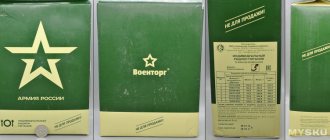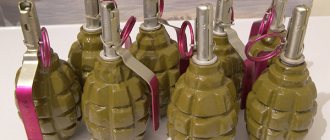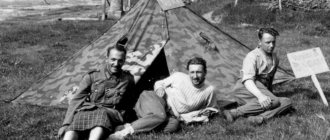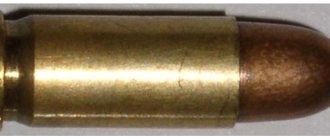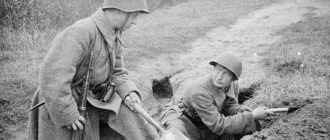The combat effectiveness of any army depends not only on its weapons, the competence of the military command or the moral qualities of its ordinary soldiers, but also on the supply of military personnel. The main one, without a doubt, is providing food for military personnel. Because you can’t fight much on an empty stomach. Since ancient times, commanders have paid great attention to this issue.
It is best, of course, to feed the soldiers hot food prepared in the field kitchen. But unfortunately, sometimes this is impossible to do. It is for this case that in the army there are individual food rations (IRP) or, in more familiar language, dry rations (packed rations). Army dry rations are a set of products that are issued to servicemen for independent nutrition in the field.
Currently, dry rations are used by all armed forces of the world. Moreover, in many countries they are freely available and are very popular among hunters, fishermen, geologists, tourists - in short, among those categories of citizens who are forced to stay away from cafes and microwave ovens for a long time. Russian army rations are no exception - you can easily buy them on the Internet.
When developing a new dry ration (IRP), as a rule, national culinary traditions are taken into account - in the Ukrainian dry ration you will definitely find borscht, and in the French one you will find meat pate.
IRP can be designed to feed a fighter for one day or several days, and there are dry rations that contain food for only one meal.
You can also add that according to domestic standards, a serviceman should not eat dry rations for more than seven days in a row. After this period, he should be switched to normal hot food.
Before moving on to the description of Russian dry rations, I would like to say a few words about the general principles of the IRP configuration and the requirements for army dry rations.
What requirements must dry rations meet?
Modern armies pay exceptional attention to the issue of personnel nutrition: serious scientific institutions or large commercial organizations are engaged in the development of dry rations. New rations are accepted for supply only after full-scale large-scale testing has been carried out.
Dry food is food for field conditions, sometimes even in extreme conditions. Therefore, its composition is calculated to the smallest detail. The IRP must fully cover the energy costs of the human body. For each specific situation, they are calculated separately, based on which the complete set of one or another dry ration is prepared. For example, dry rations for special forces or pilots contain more calories than regular infantry rations. In addition, any dry ration is almost perfectly balanced in terms of the content of carbohydrates, fats and proteins; many of them additionally contain vitamins. So, dry rations (IRP) must meet the following requirements:
- Dry ration products should be ready for use or they can be easily and quickly prepared in the field;
- Packed rations must be stored for a long time, so there is no place in its composition for perishable products: unprocessed meat, fruits or vegetables, mayonnaise, etc.;
- Products included in the IRP should be easily absorbed by the body and not cause eating disorders or allergies, even in people predisposed to this;
- IRP packaging must be durable and convenient, reliably protect its contents not only from dirt, water or mechanical damage, but also provide it with a long shelf life. In addition, it should be convenient for military personnel to carry and eat;
- The nutritional composition and energy value of dry rations must be balanced and correspond to the loads that a fighter experiences in a given situation;
- Packed rations should be tasty. Unfortunately, the Russian army began to pay attention to this requirement only in recent years.
Requirements for IRP
An individual diet must meet fairly stringent requirements, first of all this applies to the composition of products that are included in the IRP. Packed rations should:
- Long shelf life. That is, it should not contain products that quickly deteriorate: mayonnaise, fresh fruit, unprocessed meat, etc.
- Contain products that are ready to eat or those that can be easily and quickly prepared.
- Be easily digestible. That is, the IRP should include products that do not cause digestive disorders or allergies.
- Have convenient and reliable packaging, which, even in field conditions, sufficiently protected the products from exposure to water, dirt, and mechanical damage. In addition, the packaging should be convenient for the fighter to eat.
- Have a balanced nutritional composition and fully meet human needs in calories and essential nutrients and vitamins.
These are the basic requirements for a modern IRP in any army; in addition, today much attention is paid to the taste of dry rations.
The usual composition of dry rations and what should not be included in it
Based on the above requirements, there is a list of products that are most often supplied with dry rations of different armies of the world. Typically they include:
- A wide variety of canned food: stew, porridge with meat, stew, condensed milk;
- Dried or freeze-dried products: milk powder, instant soups and borscht, instant coffee, etc.;
- Rusks, biscuits, crackers;
- Food additives (sugar, salt, spices) and vitamins.
The IRP also includes devices for heating food, napkins, disposable tableware, water disinfectants, special matches, toothpicks, and chewing gum. To heat food in the field, burners of the simplest design and dry fuel are used. American dry rations, for example, include special chemical heating pads, which are used to heat food. Although, most of the products included in the IRP can be eaten cold, they will be less tasty and healthy.
Previously, the dry rations of various armies of the world also included cigarettes and condoms, but this practice has long been abandoned.
Now a few words about what cannot be in dry soldering by definition:
- Fresh vegetables or fruits;
- Products whose storage requires special conditions: temperature, humidity, etc.;
- Confectionery products with a significant cocoa content or with cream filling;
- Any food that contains a large amount of spices, table salt, cooking oil or natural coffee.
It is strictly forbidden to use any products that have not passed laboratory tests to complete the IRP.
A little about the history of the issue
Since ancient times, the issue of feeding an army on a campaign has been a serious “headache” for military leaders. How to feed a crowd of thousands of healthy men far from permanent deployment points?
In different historical periods, numerous attempts were made to create light and nutritious food that could be taken with you on a hike. The Mongols and other steppe people cut the meat thinly and placed it under the saddle on the back of the horse. There it was soaked in horse sweat, after which it was stored for a very long time. Also, the nomadic peoples of the steppe obtained from ground bones and meat an analogue of modern bouillon cubes, from which they could then prepare soup or stew. The peoples of Central America made nutritious cocoa balls. However, all of the above products were only suitable for a “snack”; they could hardly provide adequate nutrition for a healthy man.
A real revolution in supplying the army with food occurred at the end of the 18th century, when the Frenchman Appert invented canning. At the beginning of the 19th century, sailors of the British Royal Navy began to be supplied with canned food in tin cans coated with tin. We can say that this was the first sea dry ration in history. Soldiers of the Anglo-French troops during the Crimean War also received canned meat in cans.
We owe the appearance of another healthy and tasty product to the army - condensed milk. The technology for its production was invented in 1856 by the American Gale Borden. However, he was able to launch mass production of condensed milk only after the start of the American Civil War - this product was purchased in huge quantities to supply the northern army. In Russia, the first condensed milk production plant was opened in 1880.
The first dry rations, in our understanding of the word, appeared during the Franco-Prussian War. To increase the mobility of their own troops, the Prussians began to give them soup concentrates. Now each soldier could carry a supply of food for several days right in his backpack. This significantly reduced the need for tactical units in the convoy as such.
The production of a new revolutionary product was carried out by the Knorr company, which is still famous today for its instant soups. For this company, the Franco-Prussian War became a real “finest hour”.
Generals of other countries drew attention to the German innovation, and by the end of the 19th century, almost all the major armies of the world had their own dry rations. They consisted of a standardized set of products with certain nutritional properties and energy value. That is, the approach to dry rations of that time was practically no different from the modern one...
At the end of the 19th century, German quartermasters invented the so-called pea sausages - Erbswurst, which were a pack of several tablets of pea concentrate. Each of them could be dissolved in boiling water and get a tasty and nutritious soup. Erbswurst was included in the diet of German soldiers in both world wars.
During the First World War, there were three IRP standards:
- Day. Contained a set of products that could feed a soldier for one day;
- Stored. Intended to feed a soldier or officer for two to three days after separation from the main forces;
- "Iron". It consisted of various canned foods (hence the name) and could be stored for a long time. The soldier had the right to print it only after the appropriate order, in an emergency situation. Usually it occurred when the first two rations had already been exhausted, and it was impossible to ensure the supply of food.
In the Russian army there was an officer's dry ration and a soldier's dry ration.
In Russia, the first cannery producing stewed meat was built in 1870. By the beginning of the First World War, its assortment already included five types of canned meat, and they were very popular among the troops. In 1966, a can of stew made in 1916 was opened. For fifty years, the product did not deteriorate and was quite suitable for consumption. Back in 1897, Russia invented a way to quickly heat this product by mixing quicklime and water. It also found its use at the front.
The Red Army received its first dry rations only on the very eve of the war, in the spring of 1941. The reason for this innovation was the sad experience of the Winter War, which showed that it is not always possible to supply troops with adequate nutrition in a combat situation. Moreover, the problem was so acute and obvious that it was taken up at the very top - at the level of the General Staff and the Central Committee. The supply service was tasked with creating a new food package for the army in the shortest possible time. It had to be light in weight and volume, stored for a long time, and not require complex preparation and processing.
The first Soviet IRP was officially accepted for allowance on May 15, 1941. It was based on various concentrates, which could be prepared simply by pouring boiling water over them. They were designed, rather, for group feeding of soldiers, and most often they were issued to small units. Although, of course, even one fighter could make porridge from concentrate. New general daily norms for dry rations were also approved, which, in addition to concentrate, also included rye crackers, canned food or sausage, fish and feta cheese. And, of course, tea and sugar.
After the war, dry rations in the Soviet army mainly consisted of various canned foods. There were several types of rations, each of them was intended for soldiers in a particular combat situation. There was, for example, a mountain IRP, which was considered very “fatty”, as it contained chocolate and bacon. The infantry ration was much more modest. It included two cans of “meat and vegetable” canned food, a can of stew, biscuits or crackers, tea and sugar. At that time, no one bothered with group packaging; at best it was a cardboard box, but more often the fighter received his products in bulk. However, despite its unpretentiousness, the Soviet motorized rifle was not in danger of exhaustion - the nutritional value of the Soviet dry ration was 3350 kcal. In 1990, condensed milk and canned juice were officially added to packed lunches.
It should be noted that other countries followed a similar path of development, completing their IRP with canned goods. The Americans made a revolution in this area in the late 70s. Having analyzed the experience of the Vietnam War, they formulated new requirements for the individual diet of a soldier operating in isolation from the main forces. This is how the most famous dry ration in the world today appeared - MRE (Meal, Ready-to-Eat).
Its main difference from the IRP of other armies of the world was the complete abandonment of metal can packaging, which was replaced by soft plastic. The MRE was divided into packages, each of which was intended for one meal. It necessarily included a chemical flameless heater, very convenient for heating dishes. Currently, there are several dozen options for the individual MRE diet, and the US Army also supplies other types of diets, including humanitarian. Today, the American army dry ration is the most successful in terms of commercial sales; it is also available in a civilian version.
Story
The first attempts to select dry food suitable for consumption in the field were made in ancient times. IRP was required not only by soldiers, but also by travelers who traveled long distances, as well as merchants. Carrying with you a whole convoy with a field kitchen and livestock intended for food was labor-intensive.
One of the first prototypes of the IRP was rations in the Roman Empire. Legionnaires were given dry bulk products, mainly wheat. The lowest ranks were entitled to 850 grams of wheat per day, and the highest ranks and active troops were entitled to about 1 kg. It was necessary to bake bread from grain. Experienced legionnaires who lived in military camps with their families did this in their home kitchens. The rest used the common kitchen, which worked according to a schedule. The disadvantage of such a system was obvious: the troops could not eat food in dry form; it was necessary to first prepare it. This principle still worked in the camps, but did not bring results in the field.
From the time of the Roman Empire until the end of the 19th century, troops were supplied with adequate food. They were accompanied by a convoy with a herd of cattle for a constant supply of meat and milk. The convoy also had a field kitchen; cereals, vegetables and other products were transported. The convoys greatly slowed down the army, and if they suddenly fell behind the troops, the soldiers were left without provisions. The convoys themselves also had a hard time: it was difficult to maneuver with cattle, and it was easy to fall into the hands of the enemy when retreating.
The IRP in a form close to the modern one was developed during the Franco-Prussian War, in 1870-1871. The command of the German army realized that it was possible to increase the speed and maneuverability of troops by replacing the classic field kitchen with a portable one. Scientists were faced with the task of developing a food system that would allow all military personnel to carry food with them and quickly heat it up (or not heat it up at all). As a result, soup concentrates invented at that time began to be used. They were made from legumes - beans, peas. As a result of the introduction of concentrates, the following was achieved:
- increase the speed of army movement;
- abolish the system in which meals were scheduled and allow troops to take food depending on the situation;
- abandon the convoy in its classic form and distribute most of the food among the soldiers themselves;
- ensure the storage of food in backpacks, which eliminated the risk of being left without food if the convoy fell behind the army.
The famous Second Front stew during World War II
It took about 30 years for the PRI system to spread across Europe. By 1900, Great Britain, France, Russia and many other countries had their own diets. The calorie content of the diet, the ratio of KBZHU (calories, proteins, fats, carbohydrates) and the content of useful elements were calculated and controlled in laboratory conditions. Individual rations took the form of standard, regulated food sets during the Boer War, which took place from 1899 to 1902. The advantage of dry rations was that it could be consumed both hot and cold.
The modern form of the IRP was adopted at the beginning of the First World War. The scale of military clashes was enormous, and support services could not keep up with the troops. Under such conditions, various types of diets were developed:
- Day. Included a set of products for one day. This meant three meals a day: breakfast, lunch and dinner. Issued to all military personnel, it was used if units were sent on daily operations or found themselves cut off from the main personnel.
- Stripped down. A variation of the daily diet, but with reduced food consumption. A reduced menu was used if the unit was left without food supplies, and the arrival of new provisions was not expected soon. In such a case, the officers had to stretch the available supplies over as long a period as possible.
- Half. Included 1-2 meals. Used if troops were sent on a short operation (6-12 hours) without the accompaniment of a field kitchen.
- Spare. Included meals for 1-2 days beyond what was provided in the daily IRP. The reserve was used if the supply of provisions stopped for 1-2 days.
- Iron. It got its name because of the packaging: food products were placed in tin containers with thick walls. This helped extend shelf life. The iron ration was allowed to be used only in emergency situations, and permission from the officer was required.
What was included in the diet of that time? A British army officer received bread, bacon, side dishes, spices, tea, coffee, cheese and jam.
Dry rations of different armies of the world
Dry rations of the modern Russian army
In the mid-90s, the rear service of the Russian army began to develop a new dry ration, since the old Soviet IRP not only did not correspond to the spirit of the times, but simply looked like a mockery against the backdrop of Western rations that flickered every now and then on the TV screen.
The result of this work was the creation of an “Individual Diet”, which had two main varieties - field (IRP-P) and combat (IRP-B). The composition of these dry rations was officially regulated by order of the head of the military department dated July 24, 2000.
The equipment of the Russian IRP is built on the European (Soviet) principle, that is, one ration contains the amount of food that is enough to feed one soldier for a day. The caloric content of IRP-B is 3590 kcal, and IRP-P is 3360 kcal.
The “individual diet,” of course, was a huge step forward compared to Soviet dry rations. It surpassed the latter in all respects: ease of packaging, range of products, taste. The new IRP includes canned fish, dried fruits, instant coffee, jams, sausages, processed cheese and much more. Both rations had many menu options, so the soldiers did not get bored. Also included in each package were burners for heating, dry fuel, napkins, dishes, and matches. Each IRP was divided into three compartments: breakfast, lunch and dinner. In 2014, at the initiative of Shoigu, the design of the Russian dry ration was changed, and a single form of packaging was introduced for all IRPs.
In addition to the most common IRP-P and IRP-B, there are other types of similar food supplied to the Russian army, which are intended for use in special situations. There is a higher calorie ration for reconnaissance and special forces units. There are food kits for helicopter and airplane crews in distress. There is also an emergency dry ration for sailors. Special diets have been developed for divers, military personnel dealing with toxic and radioactive substances, and for pilots stationed at alternate airfields. There are also FSB dry rations and special “mountain” rations.
US Army dry rations
As mentioned above, the most famous and popular dry ration in the world is the American MRE. In addition to good taste characteristics and convenient packaging, it, like many other things related to the American army, is fairly “hyped” thanks to Hollywood. This packed lunch is packaged in thick, sand-colored plastic bags. Each of them is designed for one meal; the energy value of the products in one package is 1300 kcal.
The main dish of the menu and its number are indicated on the package. In total, there are 24 diet options, and new dishes are constantly being added to them. For example, in 2013, pizza was included in the MRE. American dry rations, unlike Russian ones, contain confectionery products. You can find cupcakes, cookies, biscuits, and candies in it.
Each box of MRE rations has an interesting “squiggle” - a “smart” sticker that can be used to judge the suitability of the products. This is a black circle in a red square. As long as the center of the circle is also red, dry rations can be safely eaten. Its darkening indicates that the IRP in the box has become unusable.
Due to the wide geography of the US military and the ubiquity of political correctness, the Americans had to develop kosher, halal and vegetarian options for the MRE menu.
The MRE ration is the most famous of the dry rations of the American army, but besides it, there are other IRPs intended for use in special conditions:
- First Strike Ration (FSR). Dry food intended for military personnel of shock units who perform tasks in isolation from the main forces, under conditions of increased physical exertion. FSR is lighter in weight and smaller in size and is designed to power for 72 hours. The approach to packaging this ration is somewhat different: FSR is a ration that is convenient to eat on the go. It contains energy drinks and high-calorie bars;
- Long Range Patrol (LRP). This dry ration is designed for military personnel who perform combat missions in isolation from the main forces for a long time. The main dish included in its composition is in dried form. This dry ration is mainly used by Marines and special forces;
- Meal Cold Weather (MCW). IRP, intended to feed soldiers in cold climates (Arctic zone). It has a high calorie content and consists of not one, but two packets. MCW's main course comes in frozen form. Calorie content – 1540 kcal.
In addition to the above types of army rations, the Americans also have the so-called humanitarian IRP - HDR (Humanitarian Daily Ration). It is intended for people in the disaster zone. It does not contain any animal products, so it is also suitable for Muslims, Jews or vegetarians. The information on the package is given as simply as possible, mainly in the form of diagrams and drawings, so that even an illiterate (or completely wild) person can use this dry ration.
Dry rations of other armies of the world
Dry rations of European armies are equipped on a different principle than American ones. One set of IRP contains the products necessary to feed a fighter for one day. For example, the composition of the French RCIR was selected, which has 14 menu options and consists of ordinary “commercial” products. Those who have tried this dry ration call it one of the most delicious IRPs. It features venison and salmon pâtés, cream pudding, Creole pork, muesli and caramel.
The German EPA also contains a daily set of products, but all of them are made specifically for the armed forces. In it you can find liver sausages, goulash with potatoes, biscuits, and juices in powder form.
The Italian dry ration, in addition to a set of products, contains 50 ml of forty-proof alcohol. The Polish IRP contains packages for two meals.
Ukrainian dry rations (2017) are a real hybrid between the European and American IRP packaging systems. It is packaged in soft plastic bags (like MRE), each of which is suitable for one meal (breakfast, lunch or dinner). But at the same time, there is also a group package that contains the fighter’s daily ration. Ukrainian dry food has good taste, but it does not come with a special chemical heating pad for heating food.
Army IRP: surviving in nature
Today's review is devoted to the individual diet of the Russian Army. It is also called dry ration or dry ration. This is 2 kg of ready-made food, quite edible, for a quick and hassle-free snack in nature.
Content
- Introduction
- Package
- Set contents
- Use
- Conclusion
Introduction
Such sets are eaten not only by soldiers in the “fields” until hot food arrives, but by those who spend a lot of time outdoors. Hunters, fishermen, diggers, etc. This is a thoughtful daily ration, I sometimes use it on one-day hikes. It's enough for two, but without dinner.
Such sets of the Russian Army are actively sold on Avito and other flea markets, warrant officers are such a people. That’s what I bought at first, but I don’t really want to meet strangers in the advertisements.
And yes, you can buy it on aliexpress, of course, with delivery from the Russian Federation. And there is convenient delivery to a post office with lockers in a supermarket near your home.
Package
The parcel with the IRP was in a transport package. The IRP itself is packaged in a cardboard box with protection from rain - the inside is covered with foil. Package dimensions: 25x18.5x9.5 cm. There is a carrying handle.
The expiration date of the set is until February 2022. The price depends greatly on the period. Can be taken as a stern man's gift, the attributes match.
And, of course, the classics. This is not an official sale from Voentorg.
Content weight:
Set contents
There are seven options for completing the ration, for the whole week, respectively. But only the main dishes change, those in aluminum packaging (lamister) 250 g. The meat in them: beef and chicken. The rest of the IRP composition is the same.
IRP dishes by numbers
IRP No. 1:
- Rice porridge with chicken and vegetables
- Meat with green peas and carrots
- Stewed beef
IRP No. 2:
- Buckwheat porridge with beef
- Goulash with potatoes
- Beef meatballs
IRP No. 3:
- Rice porridge with beef
- Meat with beans and vegetables
- Beef meatballs
IRP No. 4:
- Buckwheat porridge with beef
- Meat with green peas and vegetables
- Beef goulash with tomato sauce
IRP No. 5:
- Rice porridge with chicken and vegetables
- Goulash with potatoes
- Beef stew
IRP No. 6:
- Buckwheat porridge with beef
- Meat with beans and vegetables
- Beef meatballs
IRP No. 7:
- Rice porridge with beef
- Meat with green peas and carrots
- Beef meatballs
In this store on Ali (Radix9 Store) they send in random order. I had #6.
The rest of the IRP
- Processed cheese – 80 gr
- Natural apple puree – 100 g
- Apple jam – 45 g
- Vegetable caviar – 100 g
- Tender pate – 50 g
- Amateur sausage mince – 50 g
- Canned salted bacon – 100 g
- Army biscuits made from wallpaper flour - 2 pack (100 g)
- Army biscuits made from 1st grade flour - 2 packs (100 g)
- Chewing gum (10 tablets)
- Natural instant drink (concentrate) – 3 pcs (cherry, raspberry, peach)
- Chocolate “Officer” – 30 g
- Black tea – 2 bags of 2 g each
- Instant coffee – 1 bag
- Sugar 20 gr - 3 pack
- Dry instant cream - 2 g
- Wet wipe for hands – 3 pcs.
- Black pepper - 1 g
- Salt - 5 g
- Water disinfection tablet – 3 pcs.
- Multivitamin – 1 pc.
- Paper napkins – 3 pcs.
- Spoon layer - 3 pcs
- Plast knife - 1 piece
- Dry fuel (3 pcs) and a Taganka for warming up
- Wind and water resistant matches (6 pcs and grater)
Everything you need is included. The total calorie content of the dry ration is large, designed for an adult during physical activity. But you also need water or a water filter and a kettle.
Let's take a closer look. Let's start with the composition.
Further, the kit includes plastic cutlery, paper napkins and a portable heater (Taganok and three tablets of dry fuel) and matches that are not afraid of the wind. In winter, this may not be enough to heat all the canned food; it is necessary to shelter it from the wind.
Wet wipes, seasonings (salt and black pepper), one large “vitamin” and “Aquabreeze 2” water disinfection tablets (one tablet per liter of water) are not forgotten.
Let's move on to drinks. There is a wide choice here: tea, coffee and cream (crappy) and instant drinks (there used to be popular invites, UPI...). Why the drink is called “Invigorating” is not clear, even if eleutherococcus was added to the composition. It can be diluted in cold and hot water.
60 g of sugar is enough to make jam in the forest, and that’s understandable, they meet calorie standards. Mint chewing gum, as many as 10 small tablets.
We got to the main dish (3 pieces x 250 g), there are no preservatives in the composition:
The rest of the snacks, five more cans. Everything is quite edible, except for lard (lard), except for cleaning boots.
And finally - bread (two types of biscuits) and dessert. Chocolate is bitter.
Use
Here you need to understand this: eating this at home is not at all an option. This is canned food. But, in nature, or even after physical activity and in the cold, such food “comes in” very quickly and pleasantly. Hunger, as you know, is the best seasoning.
Everyone has different tastes, I will describe my impressions.
Pates, stews and cheese are edible. The birds will finish the lard.
And I use titanium devices from TiTo Titanium. Review. The plastic ones from the set are disposable in the literal sense of the word.
Main dishes:
Canned food is a little salty, yes, but not sour and not very fatty. The buckwheat is very dry, but the meatball gravy makes it edible. With crispy biscuits to bite into.
In order not to carry the entire box, you can buy the main canned goods separately.
Jam (sweet) and dilute drink are not invigorating, just sweet:
There is usually a minimum amount left, and then you can put the garbage in the box.
Conclusion
The products of PJSC “Gryazinsky Food Plant” are quite edible, you definitely won’t be able to get poisoned and die of hunger, although I like the local Bryansk JSC “Konservsushprod” in Starodub more. Up to 400 rub. It is quite profitable to take an IRP.
I bought IRP here
Thank you for your attention. Enjoy the shopping!
